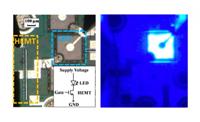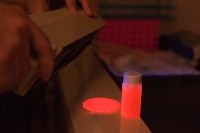New RPI research proves the concept of integrating LED emitters on the same chip with other electronic components such as transistors, while other new research focuses on maximizing the light extraction efficiency of LEDs and lowering cost through simpler materials.
Researchers at the Rensselaer Polytechnic Institute (RPI) Smart Lighting Engineering Research Center (ERC) have integrated a power transistor in gallium-nitride (GaN) layers along with an LED structure. An RPI doctoral student has also published research on a novel method that could improve the light extraction efficiency of LEDs. Researchers at the University of Washington hope to reduce the cost of slid-state lighting (SSL) products via a transition from phosphors based on rare-earth elements to electroluminescent silicon particles derived from sand.
Integrating circuit elements
The RPI research is focused on adding functionality to LED chips that can simplify the increasingly complex external electronics required to drive the LED. The laboratory project involved the monolithic integration of both a high-electron-mobility transistor (HEMT) and an LED on one chip. This simple first step of integration could provide a real benefit, eliminating the external MOSFET power transistor typically used to switch an LED on and off.

When asked whether the laboratory research would bring real value to the SSL space, T. Paul Chow, an engineering professor at RPI and the leader of the recent research, said, "Eliminating the MOSFET is the first step. We can add the gate driver circuitry, and then more integration to realize a power converter." Chow also said a single HEMT could control multiple LEDs on one chip.
The project utilized a GaN substrate and realized an LED that matches the light density of standard GaN LEDs being manufactured in volume today. So presumably there is no performance impact of integrating more functionality.
The research team has big dreams and compares the development with the evolution of transistors to dense ICs in the silicon semiconductor world. In fact, Chow calls the new type of device a light-emitting integrated circuit (LEIC).
"This new study, and the device we have created, is just the tip of the iceberg," said Smart Lighting ERC director Robert Karlicek, a co-author of the study and RPI professor. "LEICs will result in even higher energy efficiency of LED lighting systems. But what will be even more exciting are the new devices, new applications, and new breakthroughs enabled by LEICs — they will truly usher in the era of smart lighting."
The implication is LEDs that might have complex integrated functions ranging from sensors to perhaps communication capabilities or even low-end microprocessors. Chow added, "We can also integrate some sensors, and eventually a network. However, how much one will do in GaN and how much in silicon nanometer-scaled CMOS is subject to discussions, system or IC partition choices, and sometimes debate."
Silicon ICs are so much lower in cost relative to circuit real estate that GaN-based functions will likely remain focused on power-conversion circuitry and sensors. The study entitled "Monolithic integration of light-emitting diodes and power metal-oxide semiconductor channel high-electron-mobility transistors for light-emitting power integrated circuits in GaN on sapphire substrate" has been published in the scientific journal Applied Physics Letters.
Increasing extraction efficiency
Separately, an RPI student is behind an approach to increase the brightness of GaN LEDs by minimizing the photons that are trapped within the device. Notice of the research entitled "Graded-refractive-index (GRIN) structure for brighter and smarter light-emitting diodes" came to light back in February when RPI announced that doctoral student Ming Ma was a finalist for the Lemelson-Rensselaer Student Prize. Subsequently, Ma was announced as the winner of the $30,000 award and has now published the research on the International Society for Optics and Photonics website.
The research focuses on the fact that the broad difference in refractive index between GaN and air results in total internal reflection of light and extraction efficiency below 30%. The paper describes micro-pillars constructed of dielectric layers on top of the LED emitting surface that layer-by-layer provide a gradual transition in refractive index. The study revealed light extraction as high as 70%.
Silicon nanoparticles
A startup called LumiSands, meanwhile, has emerged from the Center for Commercialization at the University of Washington in Seattle that hopes to replace rare-earth phosphors with silicon nanoparticles – both lowering the cost of LEDs and SSL products and improving the light spectrum.

Hopefully, manufacturers could substitute traditional rare-earth elements with our material with minimal additional steps," said Ji Hoo, a doctoral student in electrical engineering and co-founder of LumiSands. "It will be cheaper, better-quality lighting for users." The researchers noted that rare-earth elements are expensive, dangerous to mine, and largely controlled by China.
The team has thus far demonstrated the conversion of blue LED light into red light using silicon particles that are smaller than 5 nm. They believe that they can develop yellow and green particles in short order. The combination of the three and blue LED emitters could deliver a spectrum near that of sunlight.





